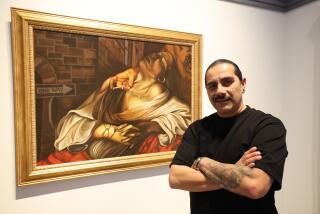Scaling the ladders of Joan Miró’s artwork
WASHINGTON — Joan Miró, the great Spanish painter of dreams and symbols, lived through so many harrowing eras of the 20th century that critics believe his masterpieces surely reflect the tensions of political events in one way or another. But Miró’s world of art was so special — with stars and moons, biomorphs and delightful dogs and sly monsters and wonderful color — that it has always been difficult to find much politics there.
An exhibition that just arrived at the National Gallery of Art — “Joan Miró: The Ladder of Escape” — makes a spirited attempt to find and explore the politics. The show, which stays on until Aug. 12, comes to the United States after enthusiastic receptions at the Tate Modern in London and the Fundació Joan Miró in Barcelona. It will not be seen elsewhere in the U.S.
The show was created by a team of curators from the Tate Modern and the Fundació Miró. As a metaphor for it, they use the title of a gouache watercolor, “The Ladder of Escape,” made by Miró in 1940. The artist, in fact, often used the ladder as a private symbol, most notably in his 1926 painting “Dog Barking at the Moon.”
According to Tate curators Marko Daniel and Matthew Gale, writing in the exhibition catalog, the ladder symbolizes Miró’s “desire for withdrawal to his own artistic world.” However, the artist often fails to ascend this ladder of escape and instead feels “no longer able to resist (the) pressures” of “worldly affairs in his work.”
The argument is a subtle one that may escape some visitors. But that does not matter. The 120 paintings, watercolors and prints cover the stages of Miró’s long career so thoroughly that they provide an exciting survey of his work even without the metaphor of a ladder. The exhibition is the most extensive display of the artist in the United States since 1993, when the Museum of Modern Art in New York mounted a huge show to commemorate the 100th anniversary of his birth.
Miró was born in Barcelona on April 20, 1893, the son of a jeweler. Following his family’s wishes, he enrolled as a teenager in a commercial school but soon devoted most of his time to lessons at La Lonja School of Fine Art. When he was 16, he made his first trip to Paris, meeting Pablo Picasso there. For much of the next 20 years, he would divide his time between France and his native region of Catalonia in Spain.
There are many gossipy stories about the famous painters of Paris in the early 20th century, but none features Miró. He did not have a succession of wives and mistresses like Picasso. Miró married Pilar Juncosa in 1929 and remained married to her until his death 54 years later. He had the demeanor of a quiet bourgeois Spaniard, wearing overalls while painting but donning a jacket and tie for social occasions.
In an interview on his 85th birthday, Miró urged a couple of reporters from the Los Angeles Times and the New York Times not to be deceived by his demeanor. “I live like a normal citizen,” he said. “But there is a Catalan saying that the parade marches inside you. What happens is inside.” The parade inside him produced a lifetime of paintings with powerful and swirling images.
Miró devoted his early work to stylized explorations of his family’s farm in the village of Mont-roig near Taragona. The best known is probably “The Farm” (1921-22), in which he set down almost every detail of a farm from a snail to trembling leafs to a barking dog to a woman washing clothes, all placed within geometric planes. Ernest Hemingway bought the painting in Paris in 1925, saying, “It has in it all that you feel about Spain when you are there and all that you feel when you are away and cannot go there.” Mary Hemingway, his widow, donated the painting to the National Gallery of Art in 1987.
Throughout his career, Miró liked to infuse his paintings with Catalan symbols and traditions. That in itself was subversive, both during the dictatorship of Miguel Primo de Rivera in the 1920s and that of Francisco Franco, from 1939 to 1975. Both regarded Catalan nationalism as a threat to the unity of the Spanish state and tried to suppress all traits of Catalan culture, including the language.
In 1924 and 1925, Miró painted a series of canvases titled “Head of a Catalan Peasant.” All displayed variations on the same features: a stick figure with large eyes, wearing the traditional red Catalan cap or barretina, and dangling a wispy beard that resembles the Catalan coat of arms. The Washington show has three of these paintings.
The artist left no doubt about his politics during the Spanish Civil War of 1936-39. He was a staunch defender of the Spanish Republic that eventually succumbed to the fascist forces of Franco. He joined Picasso in working on the republic’s pavilion in the Paris World’s Fair of 1937. Picasso painted the famous “Guernica” while Miró provided a massive portrait of a Catalan figure called “The Reaper.” This extraordinary mural disappeared after the close of the fair.
In 1937, Miró produced an aggressive and pessimistic painting called “Still Life With Old Shoe.” He regarded it as one of his finest achievements and wrote in a 1953 letter, “I later realized that without knowing it this picture contained tragic symbols of the period.” The most depressing object was a large fork stabbing a stale crust of bread.
A far different reaction came when World War II began in 1939 and Nazi Germany invaded France the following year. Miró, his wife and child were living in Normandy at the time but slipped back into Franco Spain, trying to avoid notice while quietly moving to the island of Majorca.
Beginning in France and finishing in Spain, Miró produced a series of 23 works on paper, mostly in gouache watercolor, that became known as the Constellations. This joyful and poetic series, which includes “The Ladder of Escape,” offers an outpouring of celestial happenings, brimming with stars and swirls and childish monsters, some with strange titles such as “Figures at Night Guided by the Phosphorescent Tracks of Snails.” The dealer Pierre Matisse told him, “You have attained an unprecedented degree of poetic intensity, and in the colors and in the line a dazzling mastery.” Miró had obviously tried to ascend the ladder from the turmoil around him.
However, his attitude changed after a few years back in Spain. In 1944, he produced a large group of lithographs called the Barcelona Series, perhaps his most depressing work ever. His grotesque monsters lose their impish air in the series, and the usual joy is gone. Miró could not escape the repression and poverty of Franco Spain.
The artist spent the rest of his life in Spain. Throughout the Franco years, younger artists looked upon Miró as a model for quiet opposition to the regime. He contributed drawings to clandestine Catalan magazines. Most important, he refused to cooperate with the government. As Miró’s stature increased in the world, Franco’s aides wanted to show off the artist as one of Spain’s own. They succeeded in doing so with Salvador Dalí, but Miró resisted.
In 1968, for example, Barcelona officials organized an exhibition in honor of Miró’s 75th birthday. But he refused to attend the opening ceremony. Instead, he cooperated with private artists who staged a rival exhibition called “Miró Otro” (the other Miró) and included the depressing Barcelona series.
After Franco’s death in 1975, Miró and a democratic Spain embraced each other. The Miró Foundation, chock full of art donated by the artist, opened its museum on Montjuic in Barcelona. Miró turned to public art, producing murals, wall-sized tapestries, enormous street sculptures, sidewalk mosaics and scores of posters. When he died in 1983 at age 90, he was Spain’s beloved treasure of 20th century modern art.
More to Read
The biggest entertainment stories
Get our big stories about Hollywood, film, television, music, arts, culture and more right in your inbox as soon as they publish.
You may occasionally receive promotional content from the Los Angeles Times.






